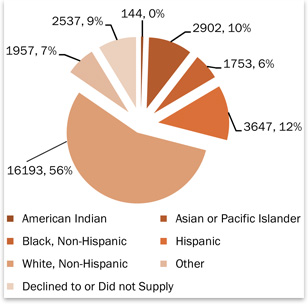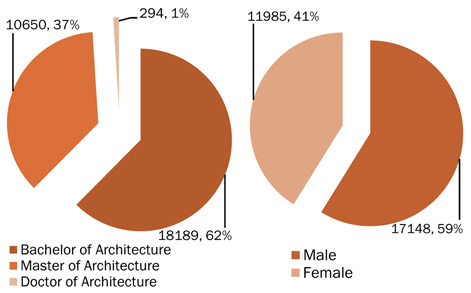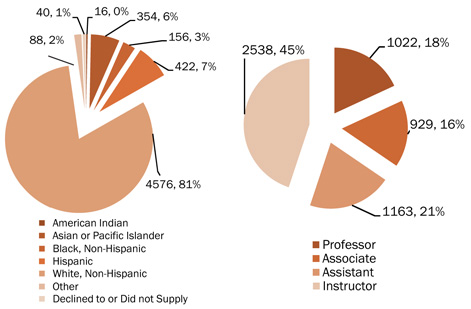The
University of Arkansas’ Fay Jones School of Architecture
Designs a Diversity Pipeline
Beginning with reaching out to new student populations
by Zach Mortice
Associate Editor
Summary: Through recruitment, outreach, and satellite programs, the University of Arkansas’ Fay Jones School of Architecture is creating a conduit to a more diverse profession. The school’s diversity initiative to target under-represented and under-utilized communities, in its sixth year, is part of a campus-wide plan, and reaches across both the school of architecture and landscape architecture. It targets adding more members of underrepresented ethnic groups and women, as well as fermenting a more generally diverse intellectual climate.

Ethnicity for NAAB-accredited BArch programs showed
33 percent minority in enrollment compared to 29 percent in overall
university enrollment whereas for MArch programs the minority enrollment
was 21 percent as compared to 29 percent for overall enrollment.
“The biggest thing we’re interested in is diversity of all sorts, whether it’s
ethnic or intellectual, or any form of diversity, because of the
potential to generate better ideas through different perspectives,” says Jeff Shannon, AIA, dean of the Fay Jones School.
A 2005 AIA demographics audit illustrates
the dearth of diversity in all these demographic categories. Only
20.3 percent of architects are female, 2.7 are African-American,
5.6 are Hispanic, and 6.3 are Asian. The Fay Jones School has more
than doubled its number of ethnic minority students since 1997 to
11.6 percent of the student body. Shannon says that for the past
several years, the architecture school has led the entire campus
in percentage increase of minority students. From 2008 to 2009, the
number of Hispanic students increased at the school by 38 percent.
The pipeline
The poor economy has stymied the school’s attempts to hire a director of diversity, and they’re still looking for more diverse faculty members to act as recruiters and role models for minority students, but they’ve been able to move forward with a number of successful diversity initiatives. The architecture school is recruiting more from high schools with higher populations of minority students, including predominately African-American schools in the Mississippi Delta region of the southeastern part of the state. Shannon and his faculty are also developing online and community college pilot courses that would introduce previously unreached student populations to architecture and landscape architecture. Northwest Arkansas, where the University of Arkansas is located, has a growing Hispanic population, and to reach out to this community, the architecture school has translated all of its recruitment materials into Spanish. In conjunction with all these recruitment efforts, the school is setting up more extracurricular study and support groups for minority students.

Gender breakdown of approximately 60/40, male to
female, is the same for BArch, MArch, and DArch degrees.
A new class called “Diversity and Design” is being offered
this fall that examines the advantages of diverse intellectual perspectives
and the synthesis and interface of diversity in design thinking.
Shannon says the class filled up with students in just over a day.
The architecture program has also been working in conjunction with a local high school’s architecture and engineering academy. The Springdale High School architecture and engineering academy helps to funnel the large Hispanic population of Springdale, Ark., into the Fay Jones School. The University of Arkansas architecture school has worked with the academy for two years, offering tours of the college facilities and helping to refine its curriculum. They’ve also specifically targeted women with this program. “Architecture not only suffers from a lack of [ethnic and racial] diversity, but also from a lack of women in practice,” Shannon says. “This was an opportunity to address both of these lacks.”
Empathic design
“The best way to attack this problem is to begin letting junior high and high school students know what the professions are like,” Shannon says. He feels that a general lack of information about the design professions is the primary reason it’s been difficult to attract students of diverse backgrounds, and he suspects this lack of awareness is exacerbated in minority communities.
Yoana Murcia, a Hispanic student at the Fay Jones School, came to the University of Arkansas from the Springdale architecture and engineering academy, and she says she had little awareness of the profession of architecture before the program. She simply liked math and science and thought the academy would be a good fit. Now a sophomore at the university, she says the high school academy (which she participated in all through high school) gave her a leg up on her fellow students, both with basic drafting and with the computer programs she would use at college. “But,” she says, “you’re never fully prepared for architecture.”

Ethnicity breakdown for faculty at NAAB-accredited
programs.
Murcia talks about the lack of experiential sustainability in architecture
and how a more diverse profession can remedy this. She highlights
the need for architects to place more emphasis on incorporating the
way diverse groups of people use, think, and feel about buildings,
thus making narrow aesthetic design concerns less relevant. Such
worldly and empathic design sensibilities might as well come packaged
in the designer themselves, as well as the community they’re
designing for.
“You learn as much as from your peers as you do from your
teachers,” she says, “and because everybody has a different
[diverse] and ethnic background, you’re learning a lot about
vernacular architecture and where they’re coming from, and
what they’ve experienced.”
|




